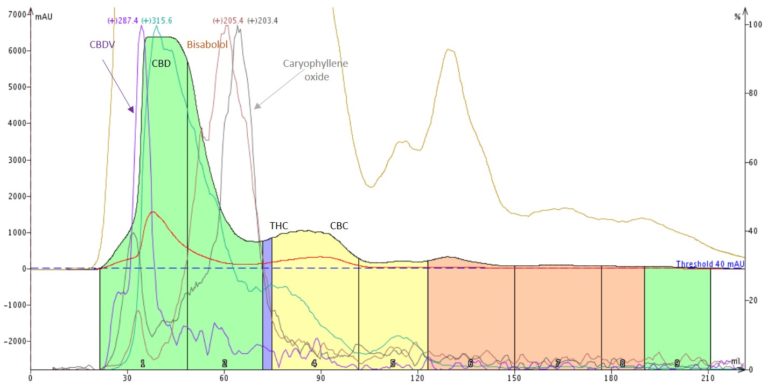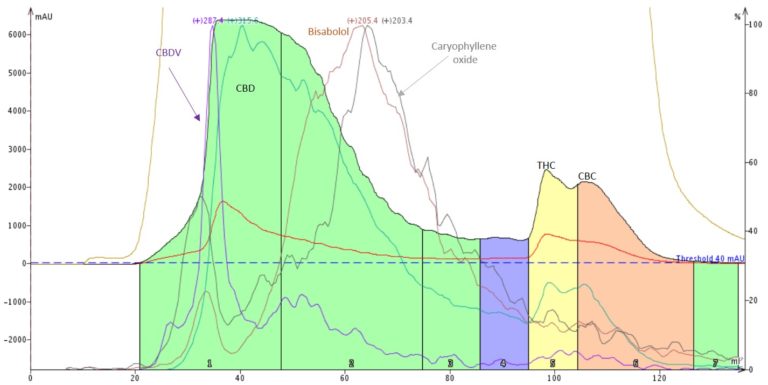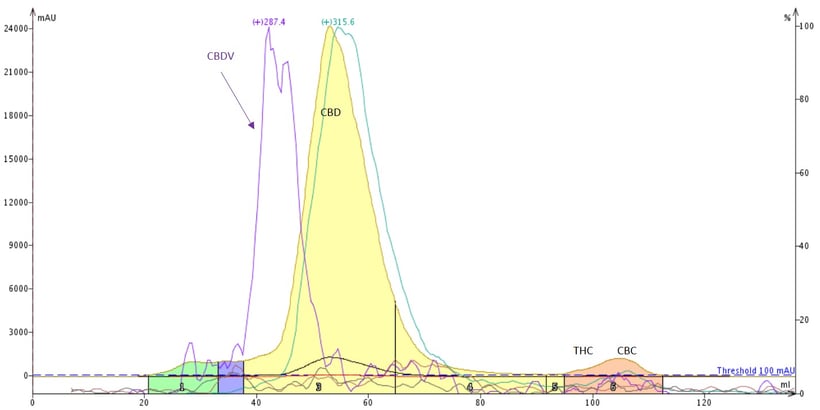We’ve looked at the biology, chemistry and the workflow so let's now get to the heart of the matter for many, the process economics. As we stated previously, we need to embrace the rigors of the commercial sector to make economically viable processes out of science. That’s where flash purification can step in.
For many years, Pharma has enjoyed the benefits of a high quality HPLC-like purification with throughput and reliability never previously dreamed of, compared to traditional glass column chromatography. They have been separating synthetic and natural products of various complexities (and more) using Flash Purification. So we thought we may be able to lend our 30 years of extensive flash purification expertise to this new and important area to help with one of the most difficult steps in the workflow.
In an early such study, we showed how a pre-packed column consisting of spherical silica particles can be used (and re-used) in order to keep production of active compounds going.
The key point is that not all silica is the same, and self-packing a glass column manually doesn’t lead to reliable or reproducible results. For over 30 years Biotage has been developing column packing techniques to provide the most consistent and most trusted normal phase and reversed phase silica solutions on the market. Consistency in process is essential if there is likely to be variability in the input oils, such as is often the case with natural products.
Experiment 1: How to rapidly remediate THC from CBD in hemp extract using flash column chromatography
Reversed-phase flash chromatography separates CBD from THC, and under the right conditions, the separation of peaks (typically one peak representing each components) can be quite large. A large separation allows increased sample loads and improved CBD purity (i.e. low THC contamination). It is common practice to start trial runs at lab or small scale, and then increase size, usually in orders of magnitude, to arrive at larger scale purification processes which are robust, and reflect the results of earlier small scale work. Currently, reversed-phase flash chromatography using water-ethanol and linear gradients (more on that later) have shown good results but tend to be long and consume a lot of solvent and require significant time (Figure 1).

Figure 1. Initial work: Hemp extract purification using a reversed-phase water-ethanol gradient (560 mg load) provides only a partial separation of CBD and THC while consuming in excess of 221 mL of solvent. X-axis: Elution volume in mL. Y-axis: UV detector response (mAU).
In our first experiment, 560 mg of hemp extract was purified on a 12 g Biotage® SNAP Ultra C18 flash cartridge, (4.6% sample load by weight). Although there is separation between CBD (large green peak) and THC+CBC (broad yellow peak), the method is long (13 column volumes = 221 mL), not including column clean-up (another 3-5 column volumes or 50-85 mL). Total solvent consumption is 271-306 mL for this small scale purification so its cost efficiency or throughput is OK but less than ideal (560 mg/290 mL). Increase scale 1000 times to purify 560 g and ~290 L of solvent would be required.
Since CBD processors need to operate at a high volume (multiple kilos of extract per day), use of a linear gradient is therefore almost cost prohibitive. Therefore, there is a need for faster, more efficient purification process that minimizes solvent consumption without sacrificing purity and load. We experimented with various reversed-phase methods and have found a way to help achieve the hemp and cannabis processor’s THC reduction goals. Rather than use a linear gradient, a step gradient is effective at drastically reducing THC contamination in a hemp extract (Figure 2).

Figure 2. Hemp extract purification using a reversed-phase step gradient of water and ethanol improved separation of CBD large green peak) from THC (yellow peak). The sample load with the step gradient increased to 800 mg while solvent consumption dropped 50%+ using the same 12 g column. Via step gradient, CBC also is partially separated from THC.
This improved method (including column clean-up) reduced solvent use by more than 50% (135 mL vs. 280 mL) and provided substantially higher recovery using the same size column. The load (800 mg) was 6.7% of the column’s media weight and 780 mg was recovered (97.5%). Of that, fraction 1 accounted for 51% of the total while fractions 5 and 6 (THC + CBC) accounted for 22%. To determine how well the step gradient worked, fraction 1 was re-purified using the same step gradient (Figure 3).

Figure 3. Re-purification of step gradient run, fraction 1, using the same method shows a dramatic CBD impurity improvement, from 75% to 99%.
The results confirm increased CBD and cannabinoid purity in fraction 1. The original hemp extract contained ~75% CBD and that was increased to 99% in some very simple steps. The remaining 1% were terpenes and other cannabinoids including CBC, THC, and CBDV. We've put together a more detailed technical article which gives some additional hints and tips.
We’ve also put together an infographic flyer outlining the workflow and throughput possible using flash purification in connection with this work.

 Organic Workflow
Organic Workflow Peptide Workflow
Peptide Workflow Scale-Up Flash Purification
Scale-Up Flash Purification  Sample Preparation
Sample Preparation Biomolecule Purification
Biomolecule Purification Oligo synthesis
Oligo synthesis Scavengers and Reagents
Scavengers and Reagents Service & Support
Service & Support Accessories & Spare parts
Accessories & Spare parts Investors
Investors Reports & News
Reports & News The Share
The Share Corporate Governance
Corporate Governance Calendar
Calendar Sustainability
Sustainability Our Offering
Our Offering Our History
Our History Our Locations
Our Locations Leadership
Leadership